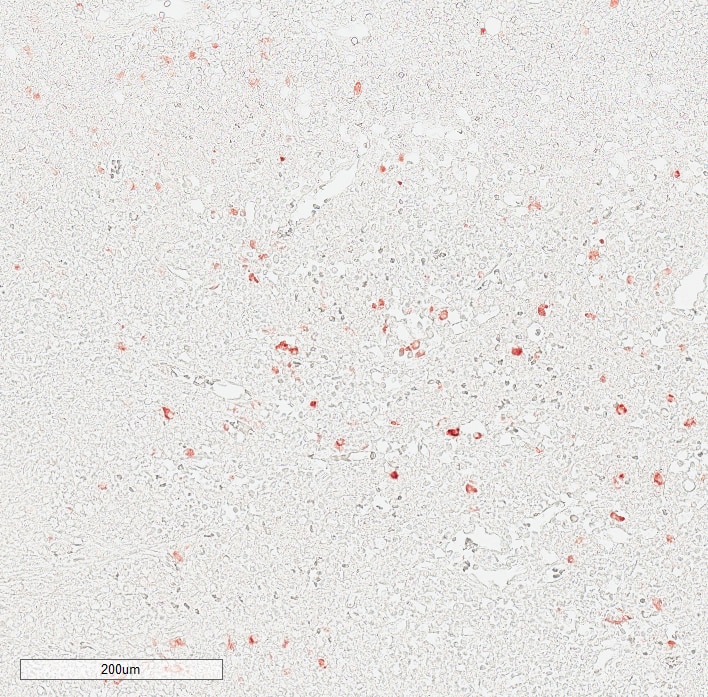| Reactivity | HuSpecies Glossary |
| Applications | WB, IHC |
| Clone | IM260 |
| Clonality | Monoclonal |
| Host | Mouse |
| Conjugate | Unconjugated |
| Concentration | 0.2 mg/ml |
| Description | 200ug/ml of antibody purified from Bioreactor Concentrate by Protein A or G. Prepared in 10 mM PBS with 0.05% BSA & 0.05% azide. Also available WITHOUT BSA & azide at 1.0 mg/ml. (NBP2-34649) Antibody with azide - store at 2 to 8C. Antibody without azide - store at -20 to -80C. |
| Immunogen | Recombinant heavy chain of human IgM |
| Localization | Cytoplasm, Cell Surface and Secreted |
| Marker | B-Cell Marker |
| Specificity | Recognizes a protein of 75kDa, identified as mu heavy chain of human immunoglobulins. It does not cross-react with alpha (IgA), gamma (IgG), epsilon (IgE), or delta (IgD), heavy chains, T-cells, monocytes, granulocytes, or erythrocytes. This monoclonal antibody is useful in the identification of leukemias, plasmacytomas, and certain non-Hodgkin s lymphomas. The most common feature of these malignancies is the restricted expression of a single heavy chain class. Demonstration of clonality in lymphoid infiltrates indicates that the infiltrate is clonal and therefore malignant. |
| Isotype | IgG1 Kappa |
| Clonality | Monoclonal |
| Host | Mouse |
| Gene | IGHM |
| Purity | Protein A or G purified |
| Innovator's Reward | Test in a species/application not listed above to receive a full credit towards a future purchase. |
| Dilutions |
|
|
| Application Notes | Immunohistochemistry (Formalin-fixed): 1-2ug/ml for 30 minutes at RT. Staining of formalin-fixed tissues requires heating tissue sections in 10mM Tris with 1mM EDTA, pH 9.0, for 45 min at 95C followed by cooling at RT for 20 minutes. Optimal dilution for a specific application should be determined. |
|
| Reviewed Applications |
|
|
| Publications |
|
| Storage | Store at 4C. |
| Buffer | 10 mM PBS with 0.05% BSA |
| Preservative | 0.05% Sodium Azide |
| Concentration | 0.2 mg/ml |
| Purity | Protein A or G purified |
| Publication using NBP2-34253 | Applications | Species |
|---|---|---|
| Balkhi MY, Willette-Brown J, Wittmann G, Hu Y. IKKa deficiency disrupts the development of marginal zone and follicular B cells Genes Immun. 2018-05-08 [PMID: 29740197] (Human) | Human |
| Images | Ratings | Applications | Species | Date | Details | ||||||||||
|---|---|---|---|---|---|---|---|---|---|---|---|---|---|---|---|

Enlarge |
reviewed by:
Verified Customer |
IHC-P | Human | 09/17/2019 |
Summary
Comments
|
Secondary Antibodies |
Isotype Controls |
Research Areas for IgM Antibody (NBP2-34253)Find related products by research area.
|
|
Early T cell response is associated with mild COVID-19 and rapid SARS-CoV-2 clearance Jamshed Arslan, Pharm D, PhD SARS-CoV-2 induces both humoral and cellular immunity. A vaccine or natural infection invokes SARS-CoV-2-specific humoral components (antibodies from activated B cells) and cellular resp... Read full blog post. |
|
Read full blog post. |
|
How To Identify B Cell Subsets Using Flow Cytometry By Victoria OsinskiUsing Flow Cytometry to Identify B Cell SubsetsIdentifying cellular subsets by flow cytometry requires careful and thorough planning in order to ensure the correct subset of cells are identified... Read full blog post. |
|
Understanding the Importance of Human IgG Human IgG is a component of the immune system that protects the body from infection. It is the most abundantly found antibody isotype within the circulatory system of the human body. All antibody isotypes contain two heavy chains and two light chains ... Read full blog post. |
The concentration calculator allows you to quickly calculate the volume, mass or concentration of your vial. Simply enter your mass, volume, or concentration values for your reagent and the calculator will determine the rest.